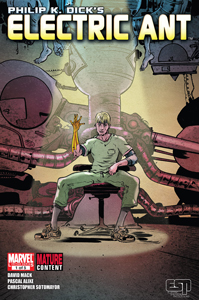I read the “Electric Ant” comic book series (2010, Marvel) and then revisited Philip K. Dick’s 1969 short story right afterward. I was surprised by how all the key points of David Mack’s five-issue adaptation are present in PKD’s brisk 17-pager.
A humanized robot
But this expansion was worth doing because Mack, artist Pascal Alixe and painter-style colorist Christopher Sotomayor make “Electric Ant” less abstract by spending more time with Garson Poole and Sarah Benton. Ironically, they humanize this story of a robot who thought he was human.
They also do the world-building that PKD might’ve done if he had expanded this into a novel. Actually, the idea of a “man” who is surprisingly an android – but a man in every non-mechanical way – is also present in “Do Androids Dream of Electric Sheep” (1968), which Dick wrote around the same time.

“Philip K. Dick’s Electric Ant” (2010)
Marvel, 5 issues
Script: David Mack
Art: Pascal Alixe
Colors: Christopher Sotomayor
Mack likewise had “DADOES” – and “Blade Runner” – on his mind. He writes the “Electric Ant” comic so it’s part of the “Blade Runner” universe. (But not officially; every time someone starts to say “replicant,” they are interrupted. Although Marvel published the “Blade Runner” adaptation in 1982, I’m guessing they didn’t hold the rights in 2010.)
The comic’s additions include the combined word “electricant” (a precursor to “replicant”); a police team coming after Garson to “retire” (kill) him when he goes haywire (a precursor to blade runners); and ground cars that transform into flying vehicles (precursors to spinners).
Don’t worry, though, this isn’t an action comic. The “action” consists of Poole talking over the situation with Sarah, and experimenting with the spool of tape in his chest. Mack retains Dick’s tight circle of characters: Poole is a corporate honcho, Sarah is both his secretary and his lover, and Danceman is both his second-in-command and his best friend.
Parallels
Mack keeps Dick’s themes fresh over five issues as he turns them over in his (and Garson’s) mind. This is one of PKD’s core works about what defines humanity and what defines reality. In my review of the short story, I said it’s the most PKD-ish of his works, and that holds true even when Mack transplants it into the “BR” world.
Along with the two core themes, “Electric Ant” shows parallels between a robot’s and human’s functions. When Garson covers up part of the tape, his experience is like a drug trip. When he malfunctions, he’s like a human with psychological troubles. A robot is to be retired in this situation, a human is to be hauled off to a padded room.
The bottom line is the person is to be removed from society for not fitting in. Dick – his own boss for most of his life — shows reluctance to embrace corporate culture. Garson loves his job because he’s programmed to love it. He’s a good boss because he’s programmed to be. For unpleasant aspects of the job (and his life), Garson has a built-in blind spot. Dick suggests that the embrace of corporate life is unnatural.

I’m citing Dick’s writing a lot in this comic review, but that’s a compliment to Mack for keeping that stuff in there.
Subtle upgrades
There’s a subtle difference, though, which ties into the PKD-to-“BR” transition: Garson is sympathetic. Dick was wigged out by the idea of simulacra becoming indistinguishable from humans. Dick’s Garson is unnatural. Mack’s Garson is a person who happens to be an android.
It’s hard to remember this in this era of human-like fictional robots such as “Futurama’s” Bender. And, heck, even Dick came up with cute machines, like the Auto Auto in “The Game-Players of Titan.” But Dick did see AI as a mark of the end of humanity, and that’s (perhaps inevitably) lost in adaptations of his work where we see the actor’s or the drawing’s human face.
Mack enhances a key moment. When Garson tells Sarah he’s an electric ant, she is fine with it, rather than being immediately shocked like in Dick’s prose. But then when Sarah sees Garson’s mechanical innards spilled out, the shock hits her.
The ending is the same in both versions, but more striking in the comic because we’ve spent more time with this tale. After almost five full issues of Garson’s POV, we switch to Sarah’s. She grapples with the idea that her entire existence is within Garson’s reality; as such, she ceases to exist when his reality-constructing tape ceases to unspool.
Dick said he was frightened by “Electric Ant’s” ending because of how easily reality transitions into emptiness. Along with his fear of AI, I can’t relate to Dick’s fear of the disappearance of reality. Certainly, subjective reality is a legitimate notion; we all live in our own words – to a point. I snap back to what our culture refers to as “reality” fairly easily, but I’m fascinated by the fact that it wasn’t so easy for Dick.
Mature content
Despite the “mature content” warning on the covers, the “Electric Ant” comic is not edgier than the story, it’s simply more immersive. It’s mature only compared to the baseline of a “Spider-Man” comic (remember, this is, bizarrely, a Marvel publication).
Garson is naked through much of the story, since he’s opening up his chassis to experiment on himself. (Alixe uses shadows and word bubbles to hide the naughty bits.) And he has a sex scene with Sarah, but it’s a backdrop for dialog where he and Sarah wonder if love crosses the human-android boundary. Alixe’s art is not for sexual provocation, although granted, if someone peeked over your shoulder, they might say “What are you reading?!”
What you’re reading is a faithful adaptation that entertainingly moves “Electric Ant” into the “Blade Runner” universe, thus allowing us to see a continuum from electricants to replicants. Some readers are probably offended by this element, but I find it to be all in good fun – a fresh way to experience a classic story.

